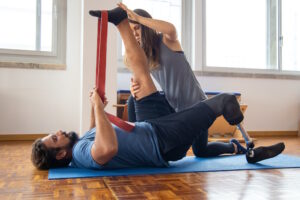
As the world’s foremost expert on Pilates Equipment for Rehabilitation, I am delighted to share my expertise with you. Pilates is a versatile and effective exercise method that can be highly beneficial for rehabilitation purposes. In this comprehensive guide, we will explore the role of Pilates in rehabilitation, the equipment commonly used in Pilates practice, the advantages of using Pilates in rehabilitation, and its effectiveness for injury recovery.
Is Pilates used for rehabilitation?
Yes, Pilates is widely used for rehabilitation purposes and has gained recognition as a valuable tool in the recovery process. Its focus on core strength, flexibility, and controlled movements makes it particularly suitable for individuals who are recovering from injuries, surgeries, or managing physical limitations. Pilates can be adapted to address various rehabilitation needs, and its low-impact nature makes it a safe option for individuals with joint issues or mobility restrictions.
Pilates is commonly incorporated into rehabilitation programs by physical therapists, chiropractors, and other healthcare professionals to help patients regain strength, flexibility, and function. It is often utilized in conjunction with traditional rehabilitation methods to provide a holistic approach to recovery.
What is the equipment used in Pilates?
Pilates equipment, often referred to as apparatus, plays a significant role in enhancing the Pilates practice. While mat-based Pilates exercises are popular and effective, the use of specialized equipment can add variety and challenge to the workouts. Some of the most common Pilates equipment used for rehabilitation includes:
1. Reformer: The Pilates Reformer is a versatile piece of equipment consisting of a sliding carriage, springs, straps, and bars. It allows for a wide range of exercises that can be modified to meet individual rehabilitation needs. The Reformer provides support and resistance, making it suitable for individuals recovering from various injuries.
2. Cadillac/Trapeze Table: The Cadillac, also known as the Trapeze Table, is a frame with various bars, straps, and springs attached. It offers a diverse range of exercises that can be tailored to address specific rehabilitation goals. The Cadillac provides excellent support for individuals with limited mobility or post-surgery.
3. Wunda Chair: The Wunda Chair is a compact piece of equipment that provides a stable surface for seated and standing exercises. It is particularly useful for targeting the core, lower body, and balance exercises.
4. Ladder Barrel: The Ladder Barrel is a semi-circular barrel attached to a ladder-like frame. It is used for exercises that focus on spinal mobility, stretching, and strengthening.
5. Pilates Ring (Magic Circle): The Pilates Ring is a flexible circle made of metal or rubber with padded handles. It adds resistance to exercises and is often used for targeting the arms, legs, and core.
What are four advantages of the use of Pilates in rehabilitation?
1. Individualized Approach: Pilates can be tailored to meet the specific needs and limitations of each individual, allowing for a personalized and comprehensive rehabilitation program.
2. Core Strength and Stability: The emphasis on core strength in Pilates helps stabilize the spine and improve posture, which is crucial for individuals recovering from back injuries or surgeries.
3. Low-Impact and Safe: Pilates is a low-impact exercise method that places minimal stress on the joints, making it suitable for individuals with joint issues or those recovering from surgeries.
4. Muscle Imbalance Correction: Pilates exercises target specific muscle groups, helping to correct imbalances that often occur as a result of injuries, promoting better overall body mechanics.
Is Pilates good for injury recovery?
Yes, Pilates is considered an excellent form of exercise for injury recovery. Its gentle yet effective approach allows individuals to work on strengthening and mobilizing muscles and joints while promoting proper body alignment. Pilates can aid in post-surgery recovery by gradually building strength and flexibility in the affected areas.
The focus on core strength and stability in Pilates is especially beneficial for individuals with back injuries or those seeking to prevent future injuries. Moreover, the controlled and precise movements of Pilates help individuals avoid overexertion and minimize the risk of re-injury.
Pilates can be modified to accommodate various injuries and conditions, making it a versatile and adaptable option for rehabilitation purposes. When guided by a qualified Pilates instructor or healthcare professional, Pilates can support a safe and effective recovery journey.
Summary
In summary, Pilates is a widely used exercise method for rehabilitation, and its equipment enhances the practice, providing support, resistance, and versatility. The Reformer, Cadillac, Wunda Chair, Ladder Barrel, and Pilates Ring are common pieces of equipment utilized in Pilates for rehabilitation. The advantages of using Pilates in rehabilitation include its individualized approach, focus on core strength and stability, low-impact nature, and ability to correct muscle imbalances. Pilates is indeed a beneficial form of exercise for injury recovery, as it can be tailored to address specific needs, promote proper alignment, and support gradual progress in strength and mobility during the rehabilitation process.